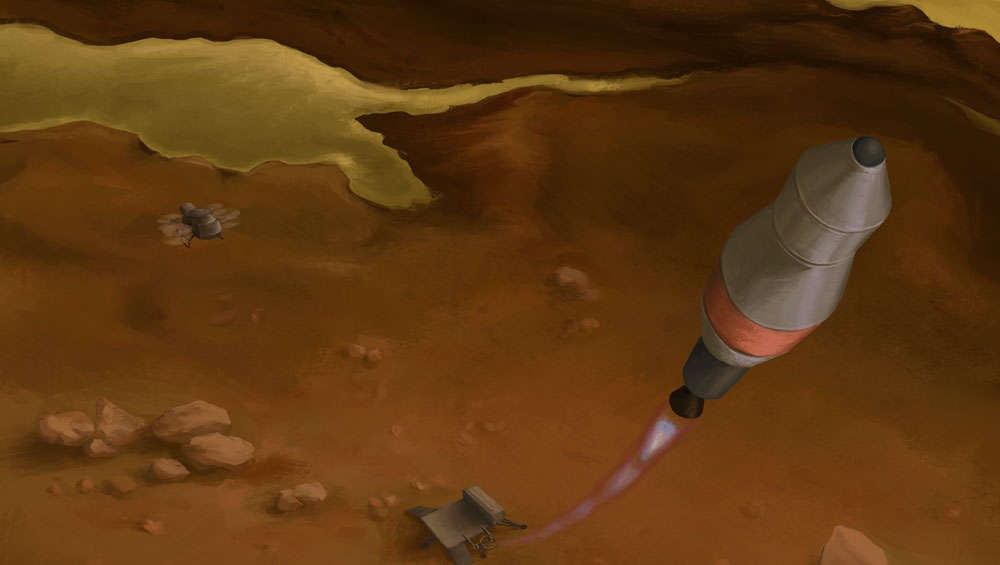Create a free profile to get unlimited access to exclusive videos, sweepstakes, and more!
Getting samples of Titan’s weird oceans and searching for alien microbes could soon become a reality

The thought of peering at Martian dust and rocks under a microscope is unreal enough, but Earthlings might eventually get their hands on alien ooze from someplace even stranger than Mars.
Titan is a hostile place. It rains freezing methane and nitrogen, which pool into poisonous rivers and lakes and oceans, at least one of which is much deeper than we thought. NASA is even considering a space submarine to take the plunge into its murky depths. For now, the space agency wants to add onto its upcoming Dragonfly mission in 2027 and send the quadcopter over there with a self-refueling sample collector that will be able to trek all over the Jovian moon without making mission control anxious about it breaking down.
This is where all that methane on Titan is going to be like the ultimate gas station that never runs out.
For now, the concept is known as A Titan Sample Return Using In-Situ Propellant until it gets a cool name or acronym. It was part of the NASA Innovative Advanced Concepts (NIAC) program that also includes a concept for that Titan submarine that might one day explore the depths of uncharted waters which aren’t really water. NASA is always seeking far-out ideas through NIAC, and some of them could end up taking space exploration to frontiers we might have never imagined before, at least outside of a sci-fi movie. The concept of a sample collector for Titan was dreamed up by the leader of NASA’s COMPASS Concurrent Spacecraft Design Team, Steven Oleson.
“This approach for Titan is very different from all conventional in-situ resource utilization concepts, and will accomplish a return of great science value toward planetary science, astrobiology, and understanding the origin of life, that is an order of magnitude more difficult…than other sample return missions,” Oleson said on the mission’s official page.
There are so many places that extraterrestrial microbes could be hiding out on Titan, and who knows what lurks beneath the surface of those methane lakes and seas. Studying samples returned from there would be fascinating even if the moon does prove to be devoid of life. Scientists want to know more about the rain cycle on Titan, a place where it’s actually supposed to rain poisionous chemicals (unlike the acid rain humans have created with pollution over here) and how that compares to precipitation on Earth. Titan also has a thick atmosphere dominated by nitrogen, which is also the most abundant gas in our own atmosphere, even above oxygen.
The Titan sample return mission is in the same vein as the one that will be bringing back the samples Perseverance leaves for pickup on Mars, but it also has some serious advantages over others like it. The Martian sample return mission will need a total of three phases, one of which is happening right now as Perseverance crawls over the desolate landscape, with scientists back on the home planet deciding where it has the best chance of digging up something that might have biosignatures or evidence of fossilized microbes.
The later sample return phases will incorporate a lander and rocket with a finite amount of fuel. The lander in the second phase will collect a cache of samples to put into orbit for a spacecraft to fly over and snatch up in the third phase. The Titan sample return mission would have less mass when taking off from Earth, which keeps launch costs low. Never mind that it would have much more time to scour Titan for signs of life and other things the bizarre moon has to reveal because of access to almost infinite fuel.
Dragonfly will spend nearly three years traversing Titan. While the nuclear-powered quadcopter won’t be able to stay alive from burning methane, it will be equipped with a Multi-Mission Radioisotope Thermoelectric Generator (MMRTG) that relies on the electricity generated by the gradual radioactive decay. That is still many levels up from your typical fuel tank or battery.
So what could be in that atmosphere or oceans? If methane-eating microbes exist right here on Earth, who knows. We'll just have to wait through the end of the decade to find out.



























